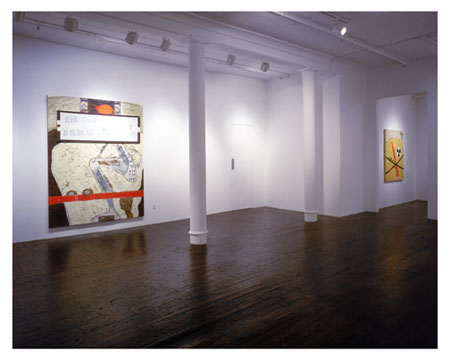Press Release
Leo Koenig Inc. is pleased to announce the opening of a solo exhibition of paintings by Ouattara Watts from the collection of Ranbir Singh. Ranbir Singh is a passionate collector of contemporary art and Mr. Watts represents a significant addition to his collection. On Mr. Watt’s work, Singh writes the following:
How does one communicate with the invisible today? Does one teach the rabbit or does the dead rabbit teach you? Ouattara’s works are far away from the literal or documentary discourse found in much art “discovered” by a western art market in Africa, and oriented toward a commercial market mainly in Europe, and to some extent, the U.S. The commercial strategy adopted by these dealers was similar to that of their forebearer’s during Europe’s colonial intrusions into Africa. The work found by these dealers is comfortably pc (pre-colonial) and uses tropes taken from billboards, folk art or documentary. It is not bad for what it really is. Unfortunately, it was dressed up for what it was not.
In the meantime, while these dealers were scouring Africa, Ouattara was beginning to cross the chasm. He arrived in Paris where he completed art studies in the mid 1980’s. In the early 1990’s, he moved to New York and continued to travel to Paris and the Ivory Coast. These travels do not appear dissimilar to many contemporary artists from America or Europe feeling the need to travel to Mali or India or, to go further back, the pull of African masks and objects for Picasso, Duchamp and Leger that helped their art travel to a new place.
In Ouattara’s works, the reading of place is felt in the yellow and orange fields that are rendered with pigmented papier-mache that the artist prepares, mixes and applies by hand. The paper used in this process is recycled newsprint, something the artist finds where he lives. It could reference the mud and grass used for walls in the ageless architecture Sudanese of Africa or adobe structures found in Sante Fe and Taos, U.S.A. or the timeless mud and dung painted layers of the great drawings by the women of Mithila, India. The fields created by this process have their own meditative and alchemical quality. The real action begins there.
Instead of a place- specific feel, what one feels in looking at Ouattara’s work is an upward movement that can be read as spiritual, a relationship between man and what is invisible to us. This universe has been glimpsed by other great American masters, such as Barnet Newman and Mark Rothko. The central form in one painting in this exhibition is a subtle reference to some sort of abstract bird or butterfly creature that has this uplifting feeling that leads us higher. The area around the bird is layered with great subtlety of surface and paint handling.
Ouattara usually makes big paintings. The works in this exhibition are smaller, by relation. Installed, the large recent works have the feeling of an Antoine Wiertz installation. Being resident in Brussels, a familiar and sympathetic place I visited often was the Wiertz studio, now a great museum on the site of this 19th century painter’s studio on Vauthier. It is the size of a small field
with 40 foot ceilings and with natural light to match the Royal Greenhouse, a few miles north. Wiertz, however, also painted great smaller works. His “La Belle Rosine,” showing Rosine, full of life, in some sort of conversation with death, symbolized by a skeleton, is less than a couple of feet in either direction and impossible to remove from memory.
Similarly, the painting, “Monk Piano,” 2002, is more intimate, compared to the larger works, and seems like a conversation in a dream with his dear, late friend, Jean Michel Basquiat. They had met in Paris-JMB was already well-known, and they connected immediately. Both loved music, both were artists, each painting for some years, one in New York the other in Paris, but meeting each other for the first time. In this painting, Ouattara ties music and art in an embrace of perhaps free abstract jazz, like a dance with JMB in another cosmic invisible dimension. The lights burn dimly at his side, but this painting is full of life.
Ouattara Watts’ paintings have most recently been seen in this year’s Whitney Biennale and in “The Short Century: Independence and Liberation Movements in Africa, 1945-1994 at P.S. 1, Long Island City New York. He currently lives and works in New York City.
